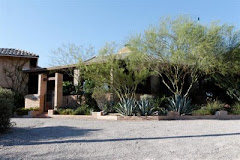On 5Nov2010 I drove up to Phoenix to pick up the custom aquarium I ordered the first of August. It is a 450 gallon acrylic tank that is 8 feet long, 2.5 feet wide, and 3 feet tall. The stand is a steel frame with a wood facade and the canopy is wood designed to my specifications since I didn't like they way they normally build canopies. The total weight of just the aquarium, stand and canopy is approximately 500 lbs. I seem to have lost some of my pictures documenting the aquarium adventure so these will have to do.
UHaul with large pallets fit to level floor above wheel well:
It took five guys to bring the stand and tank inside the house and to position it (Once it was in place there was absolutely no way for me to budge it even when empty.. Since it was too wide to fit through the garage door it had to come through the front. This meant that it had to be lifted up and over the front wall. The stand cleared the door by a 1/2 inch on each side and the tank by a full inch and a half. Whew! But if it didn't clear they could have come in through the sliding doors further down on the porch.
Laying out slate for back inside of tank:
First slate tiles are split into thin pieces by using a putty knife to work into a crack on the edge and then working a string and two putty knives to slowly separate the slate keeping the pieces as large as possible. Pliers are then used to nip the slate to dry fit it all together. I drew the outline of the sections in red pencil on the garage floor so I would know how big to make each mosaic. A picture is taken of each section and the pieces are stacked in order to aid in reassembly in the tank.
Slate is attached with 100% silicon caulk to inside back. A ladder is used to get inside the tank. Towels are used to protect the acrylic sides and top from scratching while climbing in and out.
Finished Slate background:
Pictures to Indicate Scale:
Rocks: The rocks are tumbled flagstone and some custom caves. I made the caves by spraying ABS elbows, Y's, or straights with spray polyurethance foam. After the foam cures it is cut and shaped. It is important to roughen all surfaces. The pieces are then coated with a paint consistency sandstone grout. While the grout was still wet other shades of grout in powder form are sprinkled on to add shading effects. The pieces are kept sprayed to keep moist during curing. Once cured they are soaked in water for days to leached out what ever is going to leach out. I took photos to document all of these steps but can't find them.
Dry stacking to determine layout: The flagstone was dry stacked on a big piece of cardboard marked with the size of the tank bottom.
Finished rock work:
Finished rocks with gravel added:
Plumbing:
The Tank: I had a tank disaster while on vacation for 3.5 weeks and had to practically restock my tank all over again after losing many fish. Luckily X-Tilt, the big Frontosa, survived.
My whole tank pictures are not too great due to reflections from windows and lights.
Here is a video I took with my iPhone:
The tank is mostly African Cichlids with a bunch of Clown Loaches (because they are cool and they sleep on their sides) and five Bichirs (Polypterus senegalis), a very large Plecostomus and a large Synodontis catfish. As is typical with aggressive cichlids the final inhabitants will be determined by what survives together and doesn't get killed and left to float or eaten.
Sunday, June 26, 2011
Monday, June 20, 2011
Future Posts Line Up
Since I have had many projects going on that are not completely finished for posting, here is the future post line up (in no particular order) of projects and new items.
- Downstairs tile flooring
- Monster fish tank - 450 gallons - Update: Posted 26Jun2011
- Bar area cabinets and undercounter drawer refrig/freezer - Update: Posted 8Jul2011
- Landry room cabinets
- Exterior door in laundry room - Update: Posted 9Jul2011
- Exterior door to garage
- Bat house
- Solitary bee house
- Carnivorous plants
- Anything else that comes up
Subscribe to:
Comments (Atom)















.jpg)